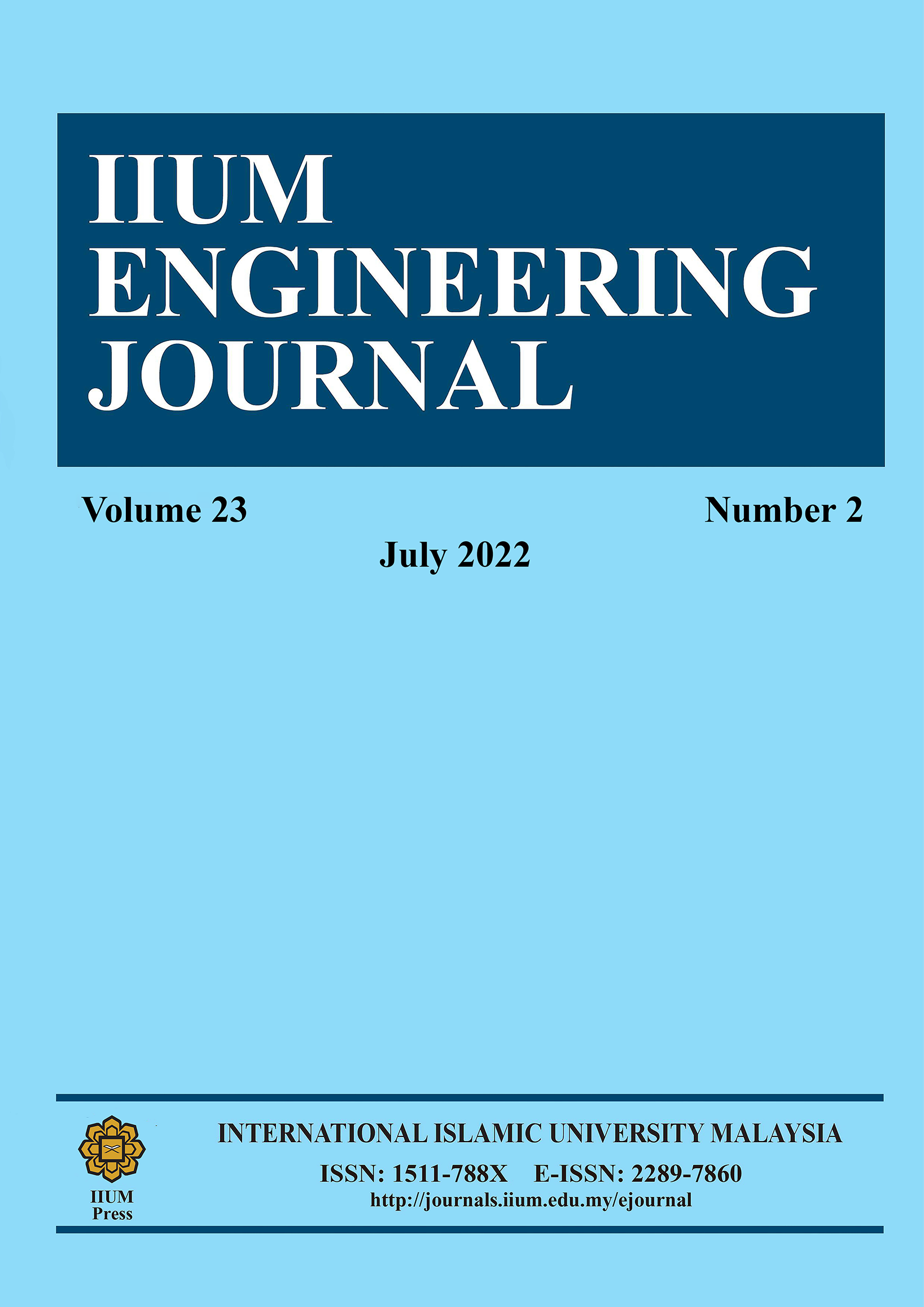Virtual Prototype-based Kinematic Modeling and Simulation of a Multi-mode Amphibious Robot
DOI:
https://doi.org/10.31436/iiumej.v23i2.2157Keywords:
Amphibious robot, Kinematic modeling, Virtual prototype, ADAMSAbstract
The amphibious robot, which has the capability of multi-mode motion, can maneuver diverse environments with high mobility and adaptability. These are employed in the area of reconnaissance, search and rescue operations, and monitoring. The existing amphibious robots have lower maneuverability over the crawling period on uneven and slope surfaces on the land. In this paper, a kinematic model of the amphibious robot based on virtual prototyping is designed for multi-mode locomotion. ADAMS (Automated dynamic analysis of mechanical systems) is a multi-body dynamic solver adopted to build the simulation model for the robot. The novel amphibious robot employs a Rockerbogie mechanism equipped with wheel paddles. The locomotion analysis on land involves straight-going and obstacle negotiation, which is simulated using ADAMS. The simulation analysis result demonstrates increased maneuverability, achieving a robot's velocity of 1.6 m/s. Normal forces on the front and rear wheels show equal load distribution, contributing more to the robot’s equilibrium over uneven terrain. The simulation result reflects the accurate kinematic characteristics of the amphibious robot and provides a theoretical basis for developing an algorithm for robot motion control and optimization. Further, this research will concentrate on the kinematic simulation maneuvering in water mode with the wheel paddle.
ABSTRAK: Robot amfibia yang memiliki berbilang mod pergerakan, dapat bergerak dalam persekitaran berbeza dengan ketinggian mobiliti dan adaptasi. Kebolehan ini dapat digunakan dalam kawasan pengintipan, operasi pencarian dan menyelamat, dan peninjauan. Robot amfibia sedia ada mempunyai kurang kebolehgerakan sepanjang tempoh merangkak pada permukaan cerun dan permukaan tidak rata pada tanah. Dalam kajian ini, model kinematik robot amfibia berdasarkan prototaip maya dibentuk berdasarkan gerak alih pelbagai mod. Sistem Mekanikal Analisis Dinamik Automatik (ADAMS) adalah penyelesai dinamik berbilang badan telah diadaptasi bagi membina model simulasi robot. Robot amfibia baru dicipta berdasarkan mekanisme Rockerbogie beserta padel tayar. Analisis gerak alih atas tanah ini termasuk gerakan-lurus dan rundingan halangan, disimulasi menggunakan ADAMS. Dapatan simulasi kajian menunjukkan peningkatan kebolehgerakan, mencapai halaju robot sehingga 1.6 m/s. Daya tujahan normal pada depan dan belakang tayar menunjukkan keseimbangan agihan beban, menyumbang lebih kepada keseimbangan robot ke atas permukaan yang tidak rata. Dapatan kajian dari simulasi menunjukkan ciri-ciri kinematik yang tepat pada robot amfibia dan menyediakan teori asas bagi membangunkan algoritma kawalan pergerakan dan pengoptimuman. Seterusnya, kajian ini mengfokuskan simulasi gerakan kinematik dalam mod air beserta padel tayar.
Downloads
Metrics
References
Karakasiliotis K, Thandiackal R, Melo K, Horvat T, Mahabadi NK, Tsitkov S, Ijspeert AJ. (2016) From cineradiography to biorobots: an approach for designing robots to emulate and study animal locomotion. Journal of The Royal Society Interface, 13(119): 20151089. DOI: https://doi.org/10.1098/rsif.2015.1089
Rafeeq M, Toha SF, Ahmad S, Razib MA. (2021) Locomotion strategies for amphibious robots-A review. IEEE Access, 9: 26323-26342. DOI: https://doi.org/10.1109/ACCESS.2021.3057406
Hopkins JK, Spranklin BW, Gupta SK. (2009) A survey of snake-inspired robot designs. Bioinspiration & biomimetics, 4(2): 021001. DOI: https://doi.org/10.1088/1748-3182/4/2/021001
Park HS, Sitti M. (2009) Compliant footpad design analysis for a bio-inspired quadruped amphibious robot. In Proceedings of IEEE/RSJ International Conference on Intelligent Robots and Systems: October 2009, pp. 645-651. DOI: https://doi.org/10.1109/IROS.2009.5354680
Boxerbaum AS, Werk P, Quinn RD, Vaidyanathan R. (2005) Design of an autonomous amphibious robot for surf zone operation: part I mechanical design for multi-mode mobility. In Proceedings of IEEE/ASME International Conference on Advanced Intelligent Mechatronics: July 2005, pp. 1459-1464. DOI: https://doi.org/10.1109/AIM.2005.1511216
Ding R, Yu J, Yang Q, Tan M. (2009) Kinematics modeling and simulation for an amphibious robot: Design and implementation. In proceedings of IEEE International Conference on Automation and Logistics: July 2009, pp. 35-40. DOI: https://doi.org/10.1109/ICAL.2009.5262984
Bi L, Guo J, Guo S. (2015) Virtual prototyping technology-based dynamics analysis for an amphibious spherical robot. In proceeding of IEEE International Conference on Information and Automation: August 2015, pp. 2563-2568. DOI: https://doi.org/10.1109/ICInfA.2015.7279717
Zhong B, Zhou Y, Li X, Xu M, Zhang S. (2016) Locomotion performance of the amphibious robot on various terrains and underwater with flexible flipper legs. Journal of Bionic Engineering, 13(4): 525-536. DOI: https://doi.org/10.1016/S1672-6529(16)60325-6
Zhuang M, Yu ZW, Gong DP, Xu ML, Dai ZD. (2012) Gait planning and simulation of quadruped robot with hydraulic drive based on ADAMS. Machinery Design & Manufacture, 7: 100-102.
Cao X, Cleghorn WL. (2010) Examples and application of ADAMS software in the mechanics of machines teaching. In 5th International Conference on Computer Science & Education: 2010; pp. 1637-1641. doi: 10.1109/ICCSE.2010.5593596. DOI: https://doi.org/10.1109/ICCSE.2010.5593596
Ding R, Yu J, Yang Q, Hu X, Tan M. (2009) Platform-level design for a biomimetic amphibious robot.In procedding of IEEE International Conference on Robotics and Biomimetics: February 2009, pp. 977-982.
Cox J, Wilfong GT. (1990) Autonomous Robot Vehicles. Springer-Verlag, N.Y. DOI: https://doi.org/10.1007/978-1-4613-8997-2
Iagnemma K, Genot F, Dubowski S. (1999) Rapid physics-based rough terrain rover planning with sensor and control uncertainty. In proceedings of IEEE International Conference on Robotics and Automation, Detroit, MI; pp. 2286-2291. DOI: https://doi.org/10.1109/ROBOT.1999.770446
Tarokh M, McDermott G, Hayati S, Hung J. (1999) Kinematic modelling of a high mobility Mars rover. IEEE Conf. on Robotics and Automation, Detroit, MI.
Kumar P. (2010) Modelling and dynamic analysis of Rocker-Bogie Rover for space exploration. PhD thesis, Indian Institute of Technology Roorkee, India.
Dudek G, Giguere P, Prahacs C, Saunderson S, Sattar J, Torres MLA, Georgiades C. (2007) Aqua: an amphibious autonomous robot. Computer, 40(1): 46-53. DOI: https://doi.org/10.1109/MC.2007.6
Baines R, Fish F, Kramer BR. (2021) Amphibious robotic propulsive mechanisms: current technologies and open challenges. Bioinspired Sensing, Actuation, and Control in Underwater Soft Robotic Systems, 41-69. DOI: https://doi.org/10.1007/978-3-030-50476-2_3
Tan J, Wang Z, Liu Z. (2006) Stable programmed manifold solver for virtual prototyping motion simulation, Chinese Journal of Mechanical Engineering (English Edition), 19(1): 76-80. DOI: https://doi.org/10.3901/CJME.2006.01.076
Liu XP, Zheng JR, Zhu ZG, Gu XL. (2003) Study on graphical data exchange between Adams/View and solidworks. Mechanical Engineer, 12.
Yu JC, Liao JW, Li MY, Li SH. (2003) Design and motion simulation of the autonomous exploration vehicle. In Proc. of the 7th International Conference on Automation Technology: September 2003; pp.1-6.
Malik SM, Lin J, Goldenberg AA. (2006) Virtual prototyping for conceptual design of a tracked mobile robot. In proceedings of Canadian Conference on Electrical and Computer Engineering: May 2006; pp. 2349-2352. IEEE. DOI: https://doi.org/10.1109/CCECE.2006.277740
Xing H, Guo S, Shi L, Hou X, Liu Y, Liu H. (2020) Design, modeling and experimental evaluation of a legged, multi-vectored water-jet composite driving mechanism for an amphibious spherical robot. Microsystem Technologies, 26(2): 475-487. DOI: https://doi.org/10.1007/s00542-019-04536-7
Ullrich F, Goktogan AH, Sukkarieh S. (2011) Design optimization of a mars rover’s rocker-bogie mechanism using genetic algorithms. In Proceedings from 10th Australian space science conference; pp. 199-210.
Thuer T. (2009) Mobility Evaluation of Wheeled all-terrain Robots - metrics and application, PhD Thesis, Swiss Federal Institute of Technology Zurich (ETH Zurich).
Saranli U, Buehler M, Koditschek DE. (2001) RHex: A simple and highly mobile hexapod robot, Int. J. Robot. Res., 20(7): 616-631. DOI: https://doi.org/10.1177/02783640122067570
Eich M, Grimminger F, Bosse S, Spenneberg D, Kirchner F. (2008) Asguard: A hybrid-wheel security and SAR-robot using bio-inspired locomotion for rough terrain. In Proceedings of . ROBIO; pp.774–779.
Yu J, Ding R, Yang Q, Tan M, Zhang J. (2013) Amphibious pattern design of a robotic fish with wheel-propeller-fin mechanisms: amphibious pattern design of a Robotic Fish, J. Field Robotics, 30: 702-716. DOI: https://doi.org/10.1002/rob.21470
Klein MA, Boxerbaum AS, Quinn RD, Harkins R, Vaidyanathan R. (2012) SeaDog: A rugged mobile robot for surf-zone applications. In Proceedings of 4th IEEE RAS EMBS Int. Conf. Biomed. Robot. Biomechatronics (BioRob): June 2012; pp. 1335–1340. DOI: https://doi.org/10.1109/BioRob.2012.6290759
Downloads
Published
How to Cite
Issue
Section
License
Copyright (c) 2022 IIUM Press

This work is licensed under a Creative Commons Attribution-NonCommercial 4.0 International License.
Funding data
-
Kementerian Pendidikan Malaysia
Grant numbers FRGS17-031-10597






















